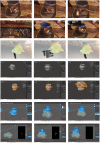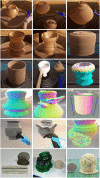PotteryVR: virtual reality pottery
- PMID: 35756580
- PMCID: PMC9208260
- DOI: 10.1007/s00371-022-02521-2
PotteryVR: virtual reality pottery
Abstract
Handcrafting ceramic pottery in the traditional method or virtual reality (VR) with intricate surface details is still challenging for the ceramic and graphic artist. Free-form pottery modeling can be efficiently geometrically modeled with the right tools with detailed 3D print outputs, yet challenging to be manufactured using traditional art. The new advanced pottery VR simulation is a promising method to recreate the traditional pottery simulation for a better experience with some barriers. The challenges that arise from surface detail in pottery are a tedious task accomplished by mesh blending and retopology. This paper focuses on refining the VP application's performance by adding unique sound resonance as a more likely infinite geometric phenomenon textures, blending it into the basic shapes. This paper combines creativity and visual computing technologies such as VR, mesh blending, fixing errors, and 3D printing to bring the ceramic artist's imagination to life. We have used sound resonance with virtual pottery (VP) systems refinements to demonstrate several standard pottery methods from free form deformed pottery, retopology, mesh blended for surface details, and 3D printed pottery with materials including polymer and ceramic resins.
Keywords: Creative technology; Evaluation; Interaction; Methods; Usability; Virtual pottery.
© The Author(s) 2022.
Conflict of interest statement
Conflict of interestAuthors declare that they have no conflicts of interest.
Figures














References
-
- Ellis, G., Dix, A.: An explorative analysis of user evaluation studies in information visualisation. In: Proceedings of the 2006 AVI workshop on BEyond time and errors: novel evaluation methods for information visualization, pp. 1–7 (2006)
-
- Gao Z, Wang H, Feng G, Guo F, Lv H, Li B. Realpot: an immersive virtual pottery system with handheld haptic devices. Multimed. Tool. Appl. 2019;78(18):26569–26596. doi: 10.1007/s11042-019-07843-3. - DOI
-
- Thornhill-Miller B, Dupont JM. Virtual reality and the enhancement of creativity and innovation: under recognized potential among converging technologies? J. Cognit. Educ. Psychol. 2016;15(1):102–121. doi: 10.1891/1945-8959.15.1.102. - DOI
-
- Yang X, Lin L, Cheng PY, Yang X, Ren Y, Huang YM. Examining creativity through a virtual reality support system. Educ. Technol. Res. Dev. 2018;66(5):1231–1254. doi: 10.1007/s11423-018-9604-z. - DOI
-
- Lee JH, Yang EK, Lee EJ, Min SY, Sun ZY, Xue BJ. The use of VR for collaborative exploration and enhancing creativity in fashion design education. Int. J. Fash. Des. Technol Educ. 2021;14(1):48–57. doi: 10.1080/17543266.2020.1858350. - DOI
LinkOut - more resources
Full Text Sources
